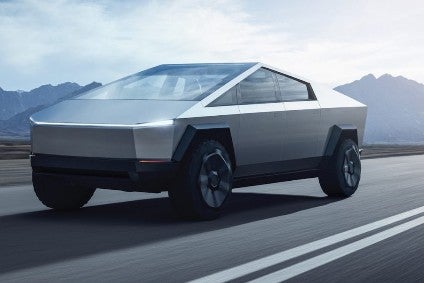
Tesla’s sci-fi-inspired Cybertruck pickup generated a tremendous amount of hype for the brand when it was first shown in November 2019. Now, however, with the company expected to miss the pickup’s targeted late-2021 launch date by at least two years, the long-awaited but still elusive model has become something of a millstone around Tesla’s neck.
Adding to its woes are the fact that battery-electric pickup rivals no longer exist solely on paper, but are now being made and delivered into customers’ hands. Already, Ford has confirmed that it has increased its production forecasts for its new F-150 Lightning BEV pickup, while the Rivian R1T and GMC Hummer EV are swiftly sewing up the luxury end of the segment. We also expect battery-electric versions of the Chevrolet Silverado, GMC Sierra and RAM 1500 to arrive before the Cybertruck, meaning Tesla’s challenger will be launching into a crowded market, rather than one it hoped to have all to itself.
Reports emerged last week that Tesla has quietly removed the option to order the Cybertruck from its Australian website. Local auto news site Drive.com.au noted that Cybertruck orders were fully refundable and advised Australian reservation holders to request a refund of their A$150 deposit. Observers have been quick to question what this move means for the wider Cybertruck production plan and whether it is indicative of any further disruption in the future. Here, we take a look at three possible interpretations of the Cybertruck’s removal from the Australian market and assess their relative likelihood:
Cybertruck project will be cancelled
The first and most pessimistic assumption we have seen in relation to reports of the Cybertruck’s removal from Tesla’s Australian website, is that this may herald the overall cancellation of the pickup project. If this is true, Tesla might have realised it was not technically or financially possible to offer the Cybertruck as originally billed and, rather than outright cancelling the whole project publicly, it will gradually remove references to it over time.
One could argue that Tesla has hinged a lot of its reputation on the Cybertruck and, if it proves to be unable to deliver the new vehicle, the brand might suffer significant reputational damage. Employing a gradual strategy of removing references and mentions of the product may serve to soften the blow Tesla would suffer from cancelling the Cybertruck.

US Tariffs are shifting - will you react or anticipate?
Don’t let policy changes catch you off guard. Stay proactive with real-time data and expert analysis.
By GlobalDataWe don’t believe this theory holds much water, however. Based on the evolution of the pickup’s design, which we covered in more detail back in June, we feel that too much active work and, therefore, R&D spend has been devoted to the Cybertruck for Tesla to simply abandon the plan. And, while the Australian market is sizeable, it is clearly less of a priority for Tesla than its key North American sales regions.
Australian Cybertruck plan changed for smaller Tesla pickup
We have also seen it suggested that Tesla might have opted to pull orders for the Cybertruck in Australia because it now intends to offer a smaller, more affordable model – akin to a Toyota HiLux or Ford Ranger – to better suit the market. This hypothetical second pickup model would likely be offered across Europe and Asia, with the full-size Cybertruck mostly focused on the North American market. This partially tallies with comments from Tesla CEO Elon Musk, who has stated the
Cybertruck is mainly a North American product.
It is true that smaller pickups are more popular in Australia and European markets but there are too many logical holes in this theory. For one, the hype surrounding the new Ford Maverick and Ranger clearly demonstrates that there is strong interest in North America for mid-size pickups, so there is no logical reason Tesla wouldn’t also market that model alongside the Cybertruck on the continent. Plus, the immense challenge Tesla continues to face in bringing Cybertruck to the market suggests it is unlikely to have a secret, second pickup project waiting in the wings to follow.
Tesla is rationalizing the markets in which Cybertruck will be sold
From our perspective, the most likely explanation is that Tesla is simply rationalizing the markets where Cybertruck will be sold. This tallies with comments from Musk regarding the truck’s North American focus, and allows the company to push the Cybertruck into production without necessarily worrying about gaining type approval for European and Asian markets.
In particular, the option to order the Cybertruck through Tesla’s website is only offered in left-hand-drive North American markets. This could indicate that the company believes it would not be cost effective to develop a right-hand-drive version for the likes of Australia, the UK or Japan.
This article was first published on GlobalData’s dedicated research platform, the Automotive Intelligence Center



